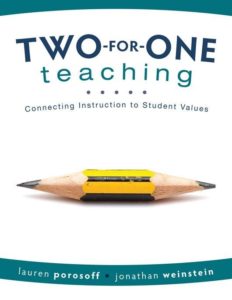Connecting Instruction to Student Values
Two-for-One Teaching: Connecting Instruction to Student Values
By Lauren Porosoff and Jonathan Weinstein
(Solution Tree Press, 2020 – Learn more)

I listen to a lot of education podcasts and participate in several Twitter chats for educators. In the process, I have come into contact with dozens of authors and heard reviews for hundreds of books.
Because of the saturation of book recommendations, I usually don’t pay much attention to the book itself; I am much more interested in what the author has to say during the interview or what snippets of wisdom they can share during a 30- or 60-minute tweet exchange.
This makes it all the more worth noticing that one book that had been in my Amazon wishlist for several months was Two-for-One Teaching: Connecting Instruction to Student Values by Lauren Porosoff and Jonathan Weinstein. (Full disclosure: while I have never met either author, I have been connected to Ms. Porosoff via Twitter for quite some time and have exchanged a few emails related to the topic of this book.)

I am often called upon to come into classrooms to observe teachers and students and provide feedback on what could be improved. A common question that educators ask me, and are asking across the world, is how we can help our students be more engaged in the classroom, particularly against the backdrop of instant gratification via social media and video gaming.
Focusing on what students value
There is no one-size-fits-all solution, but there are certainly things we can start doing that will get us much closer to finding an answer. One of those things is at the heart of Two-for-One Teaching — find out what students truly value and make it something that is not merely tolerated but actually expected within the instructional setting.
This will lead to not only academic achievement but what one school district’s mission statement describes as “achieving personal greatness.” As the authors put it, “the purpose of school – the reason underlying all the time and effort we put into educating students – is so they can live productive, satisfying, world-bettering lives, not just after they finish school, but right now.”
The foundation of values-connected instruction
For those who want to know the science and the reason supporting values-connected educational practices, I highly recommend reading Part I of this book, which comprises Chapters 1 and 2.
Chapter 1 focuses on creating a learning environment in which students (and teachers!) are willing to bring and share what they value. This is accomplished by designing learning opportunities that are actually relevant to students, help them stay mentally present, and respond to students in ways that are both instructive and supportive.
Chapter 2 presents the science of empowerment, exploring the research of contextual behavioral science, dialectical behavior therapy, compassion-focused therapy, and acceptance and commitment therapy. The purpose is not to overwhelm the reader with technical language and jargon but to present a foundation for why values-connected instructional practices are successful.
Thirty protocols to adapt to your class
Part II, which is the bulk of Two-for-One Teaching, presents an overview of 30 different protocols that can be used in different aspects of the teaching and learning process, whether it is preparing for learning, exploring new material, reviewing material, creating products that demonstrate understanding, or refining those products.
The description of each protocol is divided into the following sections: summary, preparation, implementation, boosting impact, and next steps. There is also a visual guide to approximately how much time the protocol takes to be done well.
It is worth noting that Porosoff and Weinstein do not present these protocols as strategies that must be done exactly as written and in the sequence that they are presented to be successful. In fact, they close out their book by saying exactly the opposite. Drawing a comparison to using a recipe to prepare a meal, the authors point out that each protocol can and should be adapted and modified to the meet the unique needs of the teachers and students using them.
Two-for-One Teaching is an excellent resource for any educator who wants to help connect what matters most to students with what matters most to schools. As we make these connections, we will see our students learn and grow and become the successful, productive, world-bettering members of society that we all want them to be.
Alex T. Valencic, Ed.M., is the Curriculum Coordinator for 21st Century Teaching and Learning in Freeport, Illinois. He has taught professionally for over ten years. When not working with K-12 teachers who are implementing project-based learning and other innovative strategies to support students, Mr. Valencic can likely be found reading, hiking, or spending time with his family and friends playing tabletop games.
You can learn more about his adventures in teaching fourth grade by visiting his blog Adventures in the 21st Century or by following him on Twitter @alextvalencic. This is his tenth book review for MiddleWeb.

































